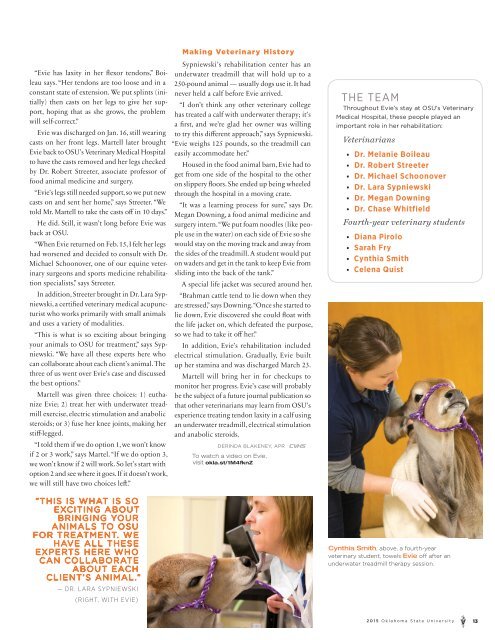Vet Cetera magazine 2015
Official magazine of the Center for Veterinary Health Sciences at Oklahoma State University
Official magazine of the Center for Veterinary Health Sciences at Oklahoma State University
You also want an ePaper? Increase the reach of your titles
YUMPU automatically turns print PDFs into web optimized ePapers that Google loves.
“Evie has laxity in her flexor tendons,” Boileau<br />
says. “Her tendons are too loose and in a<br />
constant state of extension. We put splints (initially)<br />
then casts on her legs to give her support,<br />
hoping that as she grows, the problem<br />
will self-correct.”<br />
Evie was discharged on Jan. 16, still wearing<br />
casts on her front legs. Martell later brought<br />
Evie back to OSU’s <strong>Vet</strong>erinary Medical Hospital<br />
to have the casts removed and her legs checked<br />
by Dr. Robert Streeter, associate professor of<br />
food animal medicine and surgery.<br />
“Evie’s legs still needed support, so we put new<br />
casts on and sent her home,” says Streeter. “We<br />
told Mr. Martell to take the casts off in 10 days.”<br />
He did. Still, it wasn’t long before Evie was<br />
back at OSU.<br />
“When Evie returned on Feb. 15, I felt her legs<br />
had worsened and decided to consult with Dr.<br />
Michael Schoonover, one of our equine veterinary<br />
surgeons and sports medicine rehabilitation<br />
specialists,” says Streeter.<br />
In addition, Streeter brought in Dr. Lara Sypniewski,<br />
a certified veterinary medical acupuncturist<br />
who works primarily with small animals<br />
and uses a variety of modalities.<br />
“This is what is so exciting about bringing<br />
your animals to OSU for treatment,” says Sypniewski.<br />
“We have all these experts here who<br />
can collaborate about each client’s animal. The<br />
three of us went over Evie’s case and discussed<br />
the best options.”<br />
Martell was given three choices: 1) euthanize<br />
Evie; 2) treat her with underwater treadmill<br />
exercise, electric stimulation and anabolic<br />
steroids; or 3) fuse her knee joints, making her<br />
stiff-legged.<br />
“I told them if we do option 1, we won’t know<br />
if 2 or 3 work,” says Martel. “If we do option 3,<br />
we won’t know if 2 will work. So let’s start with<br />
option 2 and see where it goes. If it doesn’t work,<br />
we will still have two choices left.”<br />
“THIS IS WHAT IS SO<br />
EXCITING ABOUT<br />
BRINGING YOUR<br />
ANIMALS TO OSU<br />
FOR TREATMENT. WE<br />
HAVE ALL THESE<br />
EXPERTS HERE WHO<br />
CAN COLLABORATE<br />
ABOUT EACH<br />
CLIENT’S ANIMAL.”<br />
— DR. LARA SYPNIEWSKI<br />
(RIGHT, WITH EVIE)<br />
Making <strong>Vet</strong>erinary History<br />
Sypniewski’s rehabilitation center has an<br />
underwater treadmill that will hold up to a<br />
250-pound animal — usually dogs use it. It had<br />
never held a calf before Evie arrived.<br />
“I don’t think any other veterinary college<br />
has treated a calf with underwater therapy; it’s<br />
a first, and we’re glad her owner was willing<br />
to try this different approach,” says Sypniewski.<br />
“Evie weighs 125 pounds, so the treadmill can<br />
easily accommodate her.”<br />
Housed in the food animal barn, Evie had to<br />
get from one side of the hospital to the other<br />
on slippery floors. She ended up being wheeled<br />
through the hospital in a moving crate.<br />
“It was a learning process for sure,” says Dr.<br />
Megan Downing, a food animal medicine and<br />
surgery intern. “We put foam noodles (like people<br />
use in the water) on each side of Evie so she<br />
would stay on the moving track and away from<br />
the sides of the treadmill. A student would put<br />
on waders and get in the tank to keep Evie from<br />
sliding into the back of the tank.”<br />
A special life jacket was secured around her.<br />
“Brahman cattle tend to lie down when they<br />
are stressed,” says Downing. “Once she started to<br />
lie down, Evie discovered she could float with<br />
the life jacket on, which defeated the purpose,<br />
so we had to take it off her.”<br />
In addition, Evie’s rehabilitation included<br />
electrical stimulation. Gradually, Evie built<br />
up her stamina and was discharged March 23.<br />
Martell will bring her in for checkups to<br />
monitor her progress. Evie’s case will probably<br />
be the subject of a future journal publication so<br />
that other veterinarians may learn from OSU’s<br />
experience treating tendon laxity in a calf using<br />
an underwater treadmill, electrical stimulation<br />
and anabolic steroids.<br />
DERINDA BLAKENEY, APR<br />
To watch a video on Evie,<br />
visit okla.st/1M4fknZ<br />
THE TEAM<br />
Throughout Evie’s stay at OSU’s <strong>Vet</strong>erinary<br />
Medical Hospital, these people played an<br />
important role in her rehabilitation:<br />
<strong>Vet</strong>erinarians<br />
• Dr. Melanie Boileau<br />
• Dr. Robert Streeter<br />
<br />
• Dr. Lara Sypniewski<br />
• Dr. Megan Downing<br />
<br />
• Dr. Michael Schoonover<br />
• Dr. Chase Whitfield<br />
Fourth-year veterinary students<br />
• Diana Pirolo<br />
• Sarah Fry<br />
<br />
<br />
• Cynthia Smith<br />
• Celena Quist<br />
Cynthia Smith, above, a fourth-year<br />
veterinary student, towels Evie off after an<br />
underwater treadmill therapy session.<br />
<strong>2015</strong> Oklahoma State University 13


